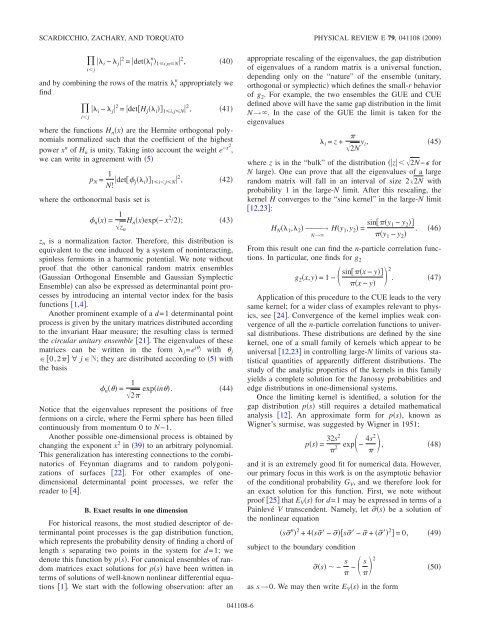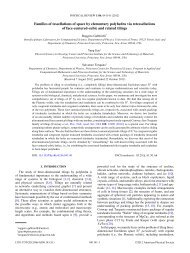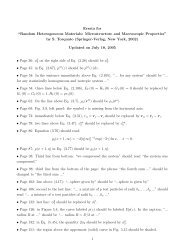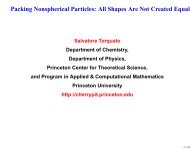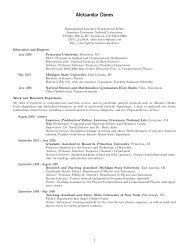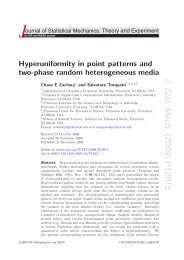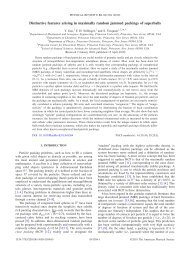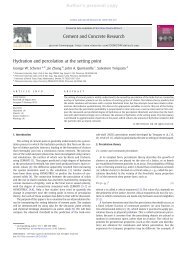Statistical properties of determinantal point processes in high ...
Statistical properties of determinantal point processes in high ...
Statistical properties of determinantal point processes in high ...
Create successful ePaper yourself
Turn your PDF publications into a flip-book with our unique Google optimized e-Paper software.
SCARDICCHIO, ZACHARY, AND TORQUATO PHYSICAL REVIEW E 79, 041108 2009<br />
i − j ij<br />
2 n<br />
= deti 1i,nN2 , 40<br />
and by comb<strong>in</strong><strong>in</strong>g the rows <strong>of</strong> the matrix i n appropriately we<br />
f<strong>in</strong>d<br />
i − j ij<br />
2 = detHji1i,jN 2 , 41<br />
where the functions Hnx are the Hermite orthogonal polynomials<br />
normalized such that the coefficient <strong>of</strong> the <strong>high</strong>est<br />
power xn <strong>of</strong> Hn is unity. Tak<strong>in</strong>g <strong>in</strong>to account the weight e−x2, we can write <strong>in</strong> agreement with 5<br />
pN = 1<br />
N! detji1ijN 2 , 42<br />
where the orthonormal basis set is<br />
nx = 1<br />
H<br />
z<br />
nxexp− x<br />
n<br />
2 /2; 43<br />
z n is a normalization factor. Therefore, this distribution is<br />
equivalent to the one <strong>in</strong>duced by a system <strong>of</strong> non<strong>in</strong>teract<strong>in</strong>g,<br />
sp<strong>in</strong>less fermions <strong>in</strong> a harmonic potential. We note without<br />
pro<strong>of</strong> that the other canonical random matrix ensembles<br />
Gaussian Orthogonal Ensemble and Gaussian Symplectic<br />
Ensemble can also be expressed as <strong>determ<strong>in</strong>antal</strong> <strong>po<strong>in</strong>t</strong> <strong>processes</strong><br />
by <strong>in</strong>troduc<strong>in</strong>g an <strong>in</strong>ternal vector <strong>in</strong>dex for the basis<br />
functions 1,4.<br />
Another prom<strong>in</strong>ent example <strong>of</strong> a d=1 <strong>determ<strong>in</strong>antal</strong> <strong>po<strong>in</strong>t</strong><br />
process is given by the unitary matrices distributed accord<strong>in</strong>g<br />
to the <strong>in</strong>variant Haar measure; the result<strong>in</strong>g class is termed<br />
the circular unitary ensemble 21. The eigenvalues <strong>of</strong> these<br />
matrices can be written <strong>in</strong> the form j=e i j with j<br />
0,2 ∀ jN; they are distributed accord<strong>in</strong>g to 5 with<br />
the basis<br />
n = 1<br />
exp<strong>in</strong>. 44<br />
2<br />
Notice that the eigenvalues represent the positions <strong>of</strong> free<br />
fermions on a circle, where the Fermi sphere has been filled<br />
cont<strong>in</strong>uously from momentum 0 to N−1.<br />
Another possible one-dimensional process is obta<strong>in</strong>ed by<br />
chang<strong>in</strong>g the exponent x2 <strong>in</strong> 39 to an arbitrary polynomial.<br />
This generalization has <strong>in</strong>terest<strong>in</strong>g connections to the comb<strong>in</strong>atorics<br />
<strong>of</strong> Feynman diagrams and to random polygonizations<br />
<strong>of</strong> surfaces 22. For other examples <strong>of</strong> onedimensional<br />
<strong>determ<strong>in</strong>antal</strong> <strong>po<strong>in</strong>t</strong> <strong>processes</strong>, we refer the<br />
reader to 4.<br />
B. Exact results <strong>in</strong> one dimension<br />
For historical reasons, the most studied descriptor <strong>of</strong> <strong>determ<strong>in</strong>antal</strong><br />
<strong>po<strong>in</strong>t</strong> <strong>processes</strong> is the gap distribution function,<br />
which represents the probability density <strong>of</strong> f<strong>in</strong>d<strong>in</strong>g a chord <strong>of</strong><br />
length s separat<strong>in</strong>g two <strong>po<strong>in</strong>t</strong>s <strong>in</strong> the system for d=1; we<br />
denote this function by ps. For canonical ensembles <strong>of</strong> random<br />
matrices exact solutions for ps have been written <strong>in</strong><br />
terms <strong>of</strong> solutions <strong>of</strong> well-known nonl<strong>in</strong>ear differential equations<br />
1. We start with the follow<strong>in</strong>g observation: after an<br />
041108-6<br />
appropriate rescal<strong>in</strong>g <strong>of</strong> the eigenvalues, the gap distribution<br />
<strong>of</strong> eigenvalues <strong>of</strong> a random matrix is a universal function,<br />
depend<strong>in</strong>g only on the “nature” <strong>of</strong> the ensemble unitary,<br />
orthogonal or symplectic which def<strong>in</strong>es the small-r behavior<br />
<strong>of</strong> g2. For example, the two ensembles the GUE and CUE<br />
def<strong>in</strong>ed above will have the same gap distribution <strong>in</strong> the limit<br />
N→. In the case <strong>of</strong> the GUE the limit is taken for the<br />
eigenvalues<br />
i = z + <br />
2N yi, 45<br />
where z is <strong>in</strong> the “bulk” <strong>of</strong> the distribution z2N− for<br />
N large. One can prove that all the eigenvalues <strong>of</strong> a large<br />
random matrix will fall <strong>in</strong> an <strong>in</strong>terval <strong>of</strong> size 22N with<br />
probability 1 <strong>in</strong> the large-N limit. After this rescal<strong>in</strong>g, the<br />
kernel H converges to the “s<strong>in</strong>e kernel” <strong>in</strong> the large-N limit<br />
12,23:<br />
H N 1, 2 ——→<br />
N→<br />
Hy1,y 2 = s<strong>in</strong>y1 − y2 . 46<br />
y1 − y2 From this result one can f<strong>in</strong>d the n-particle correlation functions.<br />
In particular, one f<strong>in</strong>ds for g 2<br />
2<br />
s<strong>in</strong>x − y<br />
g2x,y =1− . 47<br />
x − y<br />
Application <strong>of</strong> this procedure to the CUE leads to the very<br />
same kernel; for a wider class <strong>of</strong> examples relevant to physics,<br />
see 24. Convergence <strong>of</strong> the kernel implies weak convergence<br />
<strong>of</strong> all the n-particle correlation functions to universal<br />
distributions. These distributions are def<strong>in</strong>ed by the s<strong>in</strong>e<br />
kernel, one <strong>of</strong> a small family <strong>of</strong> kernels which appear to be<br />
universal 12,23 <strong>in</strong> controll<strong>in</strong>g large-N limits <strong>of</strong> various statistical<br />
quantities <strong>of</strong> apparently different distributions. The<br />
study <strong>of</strong> the analytic <strong>properties</strong> <strong>of</strong> the kernels <strong>in</strong> this family<br />
yields a complete solution for the Janossy probabilities and<br />
edge distributions <strong>in</strong> one-dimensional systems.<br />
Once the limit<strong>in</strong>g kernel is identified, a solution for the<br />
gap distribution ps still requires a detailed mathematical<br />
analysis 12. An approximate form for ps, known as<br />
Wigner’s surmise, was suggested by Wigner <strong>in</strong> 1951:<br />
ps = 32s2 4s2<br />
2 exp− , 48<br />
<br />
and it is an extremely good fit for numerical data. However,<br />
our primary focus <strong>in</strong> this work is on the asymptotic behavior<br />
<strong>of</strong> the conditional probability GV, and we therefore look for<br />
an exact solution for this function. First, we note without<br />
pro<strong>of</strong> 25 that EVs for d=1 may be expressed <strong>in</strong> terms <strong>of</strong> a<br />
Pa<strong>in</strong>levé V transcendent. Namely, let ˜ s be a solution <strong>of</strong><br />
the nonl<strong>in</strong>ear equation<br />
s˜ 2 +4s˜ − ˜ s˜ − ˜ + ˜ 2 =0, 49<br />
subject to the boundary condition<br />
˜ s− s<br />
2<br />
s − 50<br />
<br />
as s→0. We may then write EVs <strong>in</strong> the form


